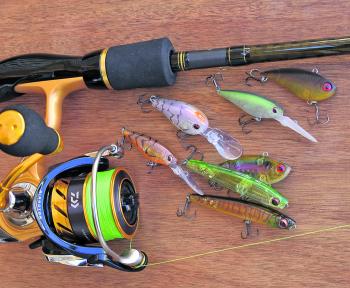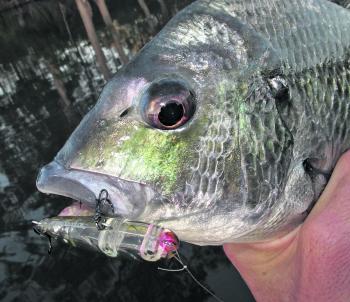Summer is a fantastic time of year for casting lures in search of the humble bream. Right now, our coastal waterways are warm and full of life such as the prey that bream love to feed on. Consequently, they’re in just the right mood to hit lures.
On the other hand, bream are notoriously fickle and not easily fooled all the time. Like most species, they have their good and bad days. Little things like changes in water temperature, wind direction, time of day and fishing pressure can mean they’ll even change their behaviour from one hour to the next. To be successful, we also need to be aware of these behavioural changes and switch tactics accordingly.
It’s not out of the ordinary for bream to become difficult or switch off altogether, while others such as flathead or whiting are still quite catchable in the same waterway. In other words, it may be a better idea to switch target species if bream aren’t playing the game. That way it’s still possible to enjoy good fishing and perhaps bring home a feed at the end of the day.
Some factors that commonly dampen the enthusiasm of bream are a north \westerly airflow, falling barometer (which tends to coincide with northwesterlies along the eastern seaboard), mornings after a clear, bright moonlit night, extremely calm conditions, extra clear water and noise or commotion from lots of boats zooming around.
Things that go in the angler’s favour include a small to moderate amount of recent rainfall, periods of hot weather to help warm the water, overcast or drizzly days, some breeze to put a ruffle on the water’s surface and a high or rising barometer. Generally speaking, the more of these factors that come together, the easier bream should be to fool with lures.
During summer, surface or topwater lures are highly effective and quite often the best sort of lure to cast for bream. In fact, it’s reasonably common for bream to ignore other lure types that sink below the surface, as bream can be very focused on looking for prawns, shrimp or insects above them, rather than taking much notice of what’s happening down deeper.
It’s possible to catch bream on surface lures at any time of day, but there’s no doubt that the early morning period, just before sunrise to an hour or two after, offers the best fishing. Late afternoon is also good. This is when light levels are lower and most fish are looking for a meal. In other words, bream are more aggressive and likely to smash surface lures with little or no hesitation.
Regardless of the exact type or size of the surface lure, more success will come when lures are thoughtfully worked and given extra life rather than simply cast out and wound back in a series of repetitive pops or side to side walking. Sure, some fish will be caught when retrieving lures like that, but twice as many can be fooled with some extra angler input.
As a starting point, let a lure sit, completely motionless, as soon as it splashes down. Bream are incredibly curious fish and just the sound of the initial splash is probably enough to attract any bream within a few metres. Competition creates aggression, so if a dozen or more bream are close to the lure, one will zoom in and grab it to beat the others to a potential meal.
This is much the same as throwing hot chips to seagulls. If only one seagull is there, it may take its time and casually approach the chip. If a mob of birds is present, a few of the more aggressive gulls are likely to fight to get the chip first. If the lure hasn’t attracted any attention after ten seconds, it’s time to make a move and see what happens next. This may be just enough to encourage any fish already considering the bite. Now that the meal is getting away, the bream will hit or at least be a step closer to hitting.
During the main part of the retrieve, back to the boat, kayak or shore, bream may be seen following the lure. If it’s quite shallow, they can’t hide the water movement created as they swim up to a lure, so keep an eye out for it. If bream are seen to be following without hitting, then one of two things needs to happen.
The first is simply a matter of stopping the lure. Now the fish can get a better look and take time to decide if they want it or not. Once again, if a number of fish are together, one is probably going to be bolder than the others and take a swipe. A lone fish may be more hesitant.
If that approach doesn’t work, try the opposite – speed up the retrieve and twitch the rod tip to make the lure splash or dart around a bit more. This sends a message to bream that the prey is panicking and trying to escape attack. Hopefully, this more agitated sort of retrieve stirs a bream into action, resulting in a strike.
Every day and every place is different, so what worked yesterday or earlier in the morning may not work again now. By mixing up these retrieve ideas and perhaps trying a different lure, the angler increases the odds of something working. Before changing a lure, try changing the retrieve.
Often seen as cool water or winter bream lures, soft plastics and sinking vibes work well at any time of year. Throughout summer, there are always some cooler patches, particularly the day after a strong southerly has moved through or if heavy rains cause some flooding – this also drops water temperature considerably.
Through the middle of the day, bream can move into deeper water where they’ll respond to a lure that gets down, rather than look for food up on top. A variety of different factors may influence the behaviour of bream and being aware of temperature drops and light levels means you’ll be better equipped to decide what sort of lure to tie on. Surface lures could do well for the first hour after sunrise, but swapping over to sinking types could keep the fish coming.
As a rough guideline, the cooler the water, the deeper and slower a lure needs to be in order to score a bite. I’ve experienced good numbers of bream hugging the bottom after heavy rainfall or flooding and they’ll still hit lures, but only when the lure is kept very close to the bottom and worked with subtle movements.
Lightly weighted soft plastics also work pretty well around structure ranging from bridge pylons and pontoons through to rockwalls and timber lined riverbanks. Sometimes they can be worked at speed, closer to the surface, while other times a bit more weight in the jig head and a slower approach is better. I’ve generally found plastics to work on fish that are reluctant to bite other lure types, especially in extra clear water.
Many years ago, hardbody lures were the main thing to throw at bream, besides bait. Some of the popular old lures were the Rebel Crawfish, Rebel Crickhoppers, 5cm Nils Masters and the Bomber Model A. While they’re still on the market and still work well, we have a lot more advanced lures to choose from these days.
I like to use these mainly in rivers or creeks, casting around fallen timber, jetties and moored boats. I don’t often use them out in my local lakes, because the lakes are so incredibly weedy around the shallows and a diving hardbody just picks up too much weed. In any case, hardbodies are a versatile type of lure that can be cast or trolled and definitely have their place in the tackle box.
There are a few other lure types worth considering, including sinking stickbaits, sinking hardbody divers and suspending hardbodies. Flyfishing is another option and was quite popular 20 years ago, but has fallen by the wayside in recent years.
Regardless of exact lure choice or angling venue, the world’s best lure won’t catch a fish by itself. Pick a good spot, check forecasts, sunrise times, moon phases and tides. Then work out what’s best to tie on the end of the line. From that point on, a mixture of careful observation, thoughtful retrieve techniques and pure persistence will bring success.
1
This nice Lake Macquarie bream took a surface lure cast over shallow flats around 11am. Conditions were overcast, with a gentle puff of breeze ruffling the water’s surface. If it was sunny and the air dead calm, it may have been much harder to entice a fish.
2
Standard bream tackle of the modern era. As great as it all looks though, success is still largely about angler observation and input. A little luck will always help, but more luck will come to those who put in the effort!
3
This fish smashed a surface lure cast towards an undercut riverbank at first light. The surface bite didn’t last long that morning, as it turned out to be a very clear, sunny day with no wind.
4
Ideal shallow water bream territory. Large clear sandy patches adjacent to weed beds are generally more productive than open expanses of sand without any other sort of structure. Dense weed beds without clear sandy patches are also less productive.
5
Slowly making your way along, casting as close to the shoreline as possible is the standard way of fishing most lakes or estuaries at this time of year. That doesn’t mean it’s not worth looking for deeper structure further out if fish aren’t coming your way. Try different things until hungry fish are found.
6
The author picked up this solid fish on a Gulp worked in deeper water. Although surface luring is very popular and definitely effective at this time of year, it’s still worth going deeper and slower if the water seems on the cool side.
7
Bream find plenty of food and shelter around weedy areas, but they’re more likely to be hooked over clear patches or channels running near weed, rather than right in the middle of a large weed bed.
8
This bream was caught on a trimmed up Berkley Gulp and jighead with some weight nipped off it. Sometimes a little modification will make a big difference when using softies or other lure types.
Reads: 6210











